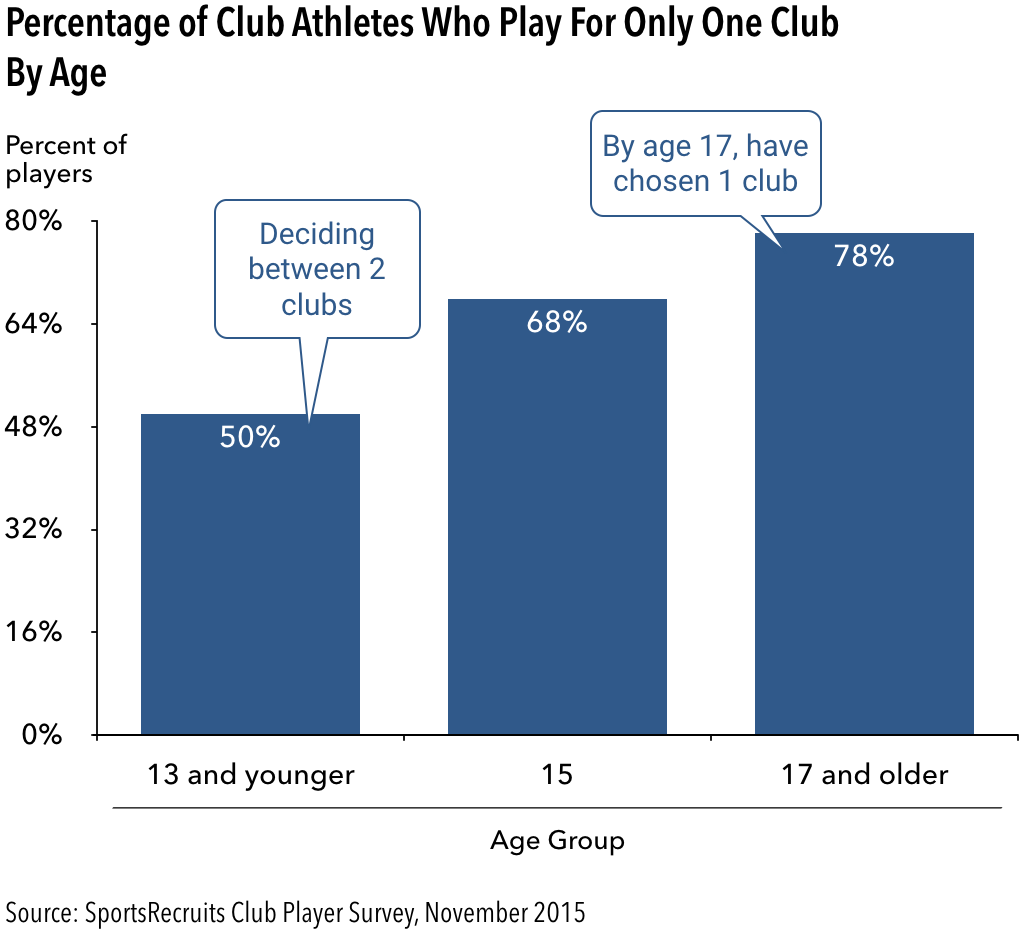Abstract
Across every sector of the economy, the membership model is shifting the way people conduct and interact with business.
Thanks in large part to the prevalence of technology in daily routines, there has been a movement from one-time transactions toward a community that is ever-present, capable of meeting needs on demand across multiple platforms and devices.
Club sports organizations can take valuable lessons from this economic trend. This paper discusses the multitude of benefits imbued by this new paradigm and the ways clubs can capitalize on it.
By adopting just a few of the core tenets of the membership model, clubs can provide their families with better coaching, more specialized training programs, and more individualized guidance, while simultaneously reducing the workload and demands for club staff.
Introduction
In her seminal work on the topic, The Membership Economy: Find Your Super Users, Robbie Kellman Baxter deftly explores how the economy in the past decade has shifted from a transactional one to one with a membership focus.
“Evolving technologies have dramatically enhanced the ability of a broad range of industries to take advantage of membership models,” says Baxter. “The Membership Economy is all about putting the customer at the center of the business model rather than the product or transaction.” (p. 23).
Club sports organizations are by definition membership driven. However, there are many advantages of this movement toward a Membership Economy of which they are not currently taking full advantage.
The old model was based on the transfer of ownership of a good or service from seller to buyer. A business creates something valuable, and consumers pays to buy it from them. The new model is about access. Businesses create and continually improve their products, and consumers pay to use them. Typically, consumers can access them whenever they want, on whatever device is most convenient.
Consumers are willing to trade abundance for convenience; permanent ownership of what they value now for conditional access to what they might potentially value in the future. This, in a nutshell, is the Membership Economy.
Using Baxter’s work as a guiding force, this paper will first briefly define the principles of the Membership Economy, noting the essential elements and key points. It will then explore practical ways in which clubs can harness this shift in thinking, as well as define the benefits to making these changes.
Principles of the Membership Economy
Early in her work, Baxter cites Netflix to assist in explaining the idea of the Membership Economy. She notes that the company first changed the game by offering on-demand mailings of DVDs (which replaced physical transactions at places like Blockbuster) before shifting full-time to a model based completely online.
What this set the stage for, broadly, was thinking about membership as a catalyst for business. Being a member means access anytime, anywhere you’d like. The company is offering the same thing it always has — movies and television shows — but the transactions have been replaced. One-for-one DVD rentals are now an on demand library.
Why are most businesses moving toward this model? Baxter defines three reasons:
- It creates recurring revenue and removes cash flow lumpiness.
- It builds a more direct relationship.
- It generates an ongoing flow of information.
We have covered previously how these relate to club organizations. For example, recurring revenue in clubs simply means attempting to provide enough value to not have families leave your club – an idea called “customer churn.”
Building a direct relationship with families means adopting best practices that allow a family to feel the value a club provides. An ongoing flow of information is saying technology can provide you an outlet and insights you previously may not have had.
Club sports organizations are by definition membership driven. However, there are many advantages of this movement toward a Membership Economy of which they are not currently taking full advantage.
Technology has allowed businesses to build ongoing relationships with their customers, giving them new, easier avenues by which to provide the same value.
The question for clubs, then, is how they can go about implementing small changes in-line with this model that can pay dividends for both their families and them moving forward.
How Clubs Can Practically Implement the Membership Economy Ideals
[ecko_toggle style=”solid” state=”open” title=”Schedule a Demo”]
Want to see how our platform can work for your organization? Schedule a demo here.
[/ecko_toggle]
Remember, in the membership model, customers pay for access to a consistently-improving suite of goods and services. Customers want to continue paying membership dues, because they value what you provide and don’t want to lose access to it.
Clubs already provide families with tremendous value. Internet-enabled technology allows clubs to provide those same services in a manner that is quicker, more convenient, and even more personalized than ever before. A recent survey conducted by SportsRecruits found that 82% of families rate coaching and recruiting expertise as the most important 2 factors they want their clubs to provide.
Below, we discuss how club sports can enhance their efforts in these areas and provide actionable methods for implementing this new model.
Coaching
The greatest coaches know that coaching is as much about what they do off the field as it is about what they do on it. Traditionally, clubs have been faced with a high barrier to providing exactly the type of off-the-field training that distinguishes excellent coaching from something less: time.
Players have school from 9am-4pm and homework from 7pm-10pm, leaving a short window for club sports. In this window, parents are finishing work and preparing dinner. Simply put, only the player is able to interact with their club and directly experience the value their club is creating.
Technology allows your club to deliver valuable off-the-field coaching that is unconstrained by physical location, schedule conflicts, or prior commitments.
1. Create a library of skill drills and instructional materials. Good players don’t become great during the 10 hours per week they spend at practice or in games. They become great in the 158 hours left over. These are the hours where clubs can leverage technology to provide tremendous value. If your coaches already prescribe individual drills or exercises they should be doing after practice, it’s likely you can make them more useful by posting them online so players can access them whenever they have time, wherever they are.
2.Instructional videos. Skill exercises require good form and technique. The mechanics are crucial – and it’s extremely difficult to convey the correct mechanics with words alone. The same type of in-person instruction club coaches provide on the field can be provided online. Record drills in practice and highlight the proper way to execute specific movements. This is incredible value that families aren’t going to find anywhere else. And given the ubiquity of smartphones that can capture HD video at up to 240 frames-per-second, clubs can do it at minimal cost.
College Recruiting
The club sports space has opened recruiting avenues previously accessible to only a very small subset of student-athletes located in heavily recruited “hotbed” areas. Technology is expanding this access even further, allowing kids across the country to get exposure from the college coaching community, without the steep financial burden of physical travel. This technology also allows clubs to provide even greater assistance to Clubs have an opportunity to capitalize on this development in a major way.
Here are a few simple ways to do so:
1. Post your “Recruiting Night” slides online. Many clubs organize periodic “Recruiting Nights” for players and their families. These allow club staffers to outline their approach to recruiting for club players, to instruct players on what is expected of them, and address questions from families on a confusing and stressful topic. Make the slides available online, so that families can reference them after the fact and can benefit from them whether they were able to make the meeting or not.
2. Provide a recruiting portal. By recruiting portal, we simply mean a centralized online location where players can conduct, organize, and seek guidance about the recruiting process. While you are an expert in athletic recruiting with years of experience, for most families, the process is new and confusing. This portal should be a home base for all their recruiting efforts. Clubs can actively help players get recruited, but ultimately, success in the recruiting process is determined by the hard work of the player. If club membership affords them access to the tools to take ownership of their recruiting processes, and you’ll never have to worry about them leaving your club.
3. Monitor player’s progress and provide timely, targeted feedback. This is traditionally one of the toughest duties for club staff to perform. Even if your club has the resources to work with each player individually at regular enough intervals to make a difference, you still have to trust that players are doing what they tell you they’re doing (contacting schools, organizing their videos, etc.). Additionally, research shows that parents are often more engaged in the recruiting process than the players. You interact with your players multiple times per week, but many parents are too busy to meet with their kids’ clubs regularly. Fortunately, this process can be managed automatically with software that tracks each player’s progress and compiles it for you.
The Benefits of These Changes
A major benefit of the Membership Economy is that it creates customer loyalty by increasing value. When value is higher, loyalty increases. When loyalty increases, members do not want to leave. Bonds are created and fostered.
While this sounds great theoretically, it can be quantified. In a November 2015 of club families conducted by SportsRecruits, 50% of athletes under the age of 13 play for more than two clubs. However, by the age of 17, 78% of players are only playing for one club team.
Therefore, building loyalty is of vital importance. Per the numbers, an overwhelming majority of families will choose one club as they get older.If choosing the other club means forfeiting access to a suite of valuable tools that they need and have grown accustomed to using regularly, they will be far more hesitant to do so.
As discussed, implementing changes – some smaller, some larger – will allow a family to fully realize the value you as a club are providing. Implementing aspects of the Membership Economy model will put the members first, increase their loyalty and allow clubs to affect positive change.
Conclusion
The Membership Economy is an economic shift in thinking that puts members first. It provides new channels for interaction, and builds loyalty via a direct relationship with a consumer. By adopting the principles of this shift, club sports organizations can put themselves on the leading edge of the industry while simultaneously increasing the assistance they provide.



